C9550-275 Online Practice Questions and Answers
On a project, the BPM analyst defined the following to identify the Key Performance Indicator (KPI):
- The goal of the project was to improve the efficiency of the process.
-
The concern was that the process was not fast enough.
-
The Critical to Quality (CTQ) was the speed of the process.
-
The client was interested in the cycle time of the process.
- The time stamps at the beginning and at the end of the process are captured.
Which step did the BPM analyst fail to perform in identifying the KPI?
A. Know the client objectives
B. Know how to define the client's KPI
C. Know the process decision makers
D. Know the client's Service Level Agreements (SLAs)
A BPM analyst is conducting interviews with the participants of a business process. What feedback about the process should the BPM analyst look out for that might not be obvious in an as-is process diagram?
A. Excessive reviews
B. Too many participants
C. Identification of bottlenecks
D. Not enough system automation
The project manager needs assistance from the BPM analyst in building a process roadmap. What tool should the BPM analyst use to create a detailed list of areas of opportunity?
A. A Prioritization Matrix
B. A Root Cause Analysis Matrix
C. A Business Value Add Analysis Matrix
D. A Failures Mode Effect Analysis (FMEA) Matrix
A BPM analyst needs to make a change to the connections in the following process diagram. The order of activities needs to be changed so that "Grind Beans" is followed by "Brew Coffee". "Heat Milk" will come last after "Brew Coffee".
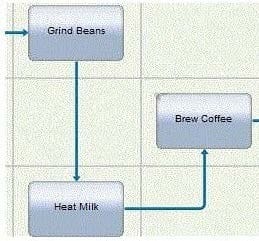
How should the BPM analyst make this change to the connection?
A. Click on the "Brew Coffee" activity and drag it onto the connection between "Grind Beans" and "Heat Milk"
B. Click on the "Grind Beans" activity and drag it onto the connection between "Heat Milk" and "Brew Coffee"
C. Click on the connection between "Heat Milk" and "Brew Coffee" and drag the connection arrow to "Grind Beans"
D. Click on the connection between "Grind Beans" and "Heat Milk" and drag the connection arrow to "Brew Coffee".
A BPM analyst has modeled the process for creating a custom coffee beverage. The BPM analyst noticed a lot of detail in the process model and has started refactoring the model to reduce the complexity.
Which section of the process represents a series of activities performed by the same participant that the analyst reduced into a single activity?
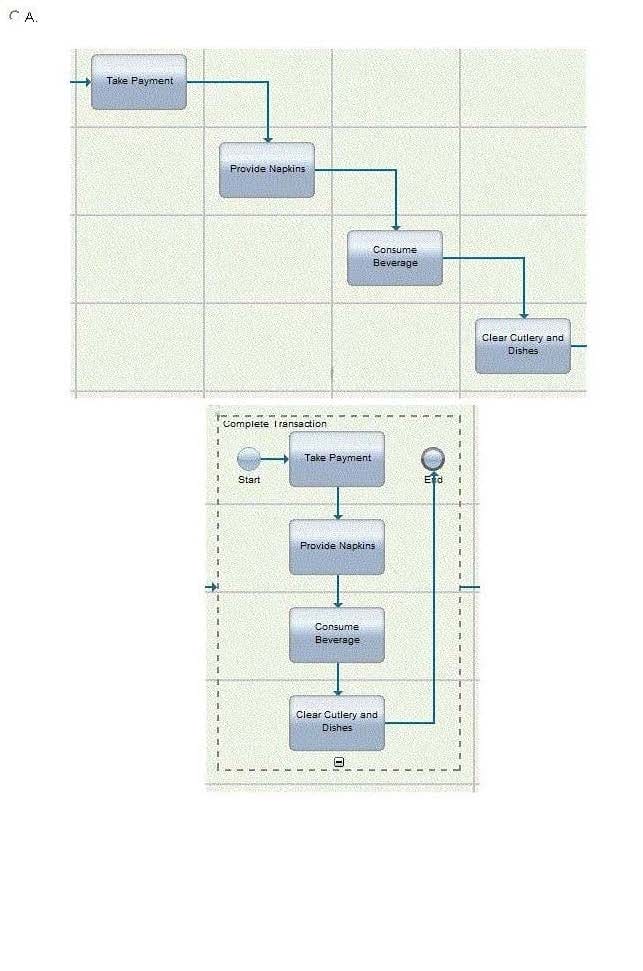
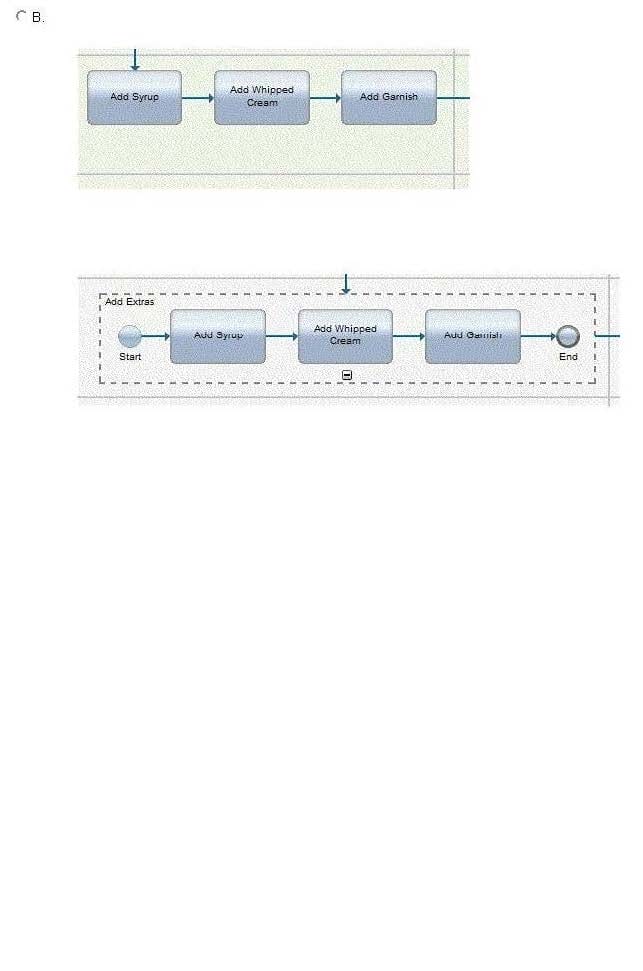
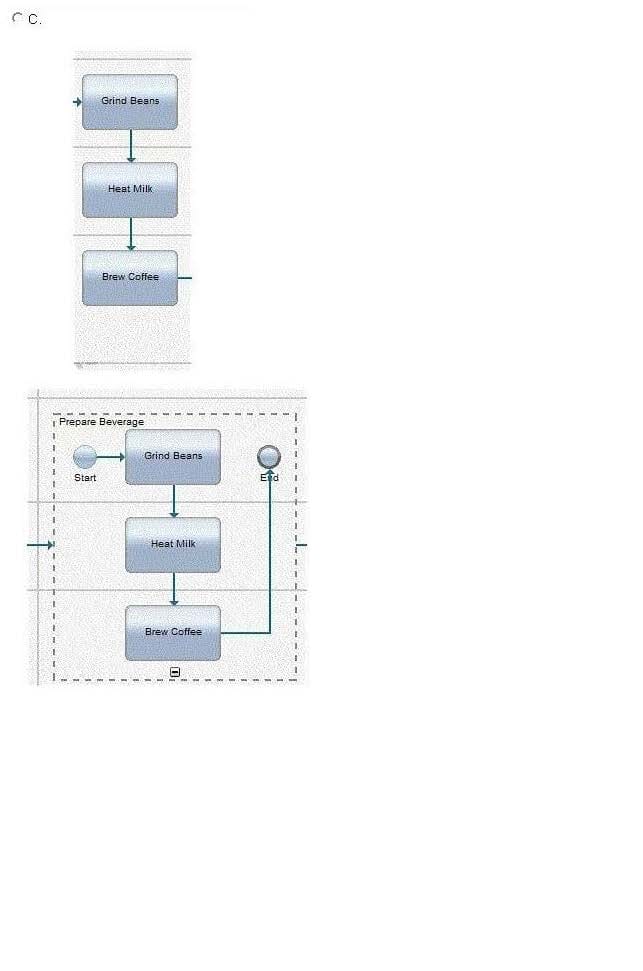
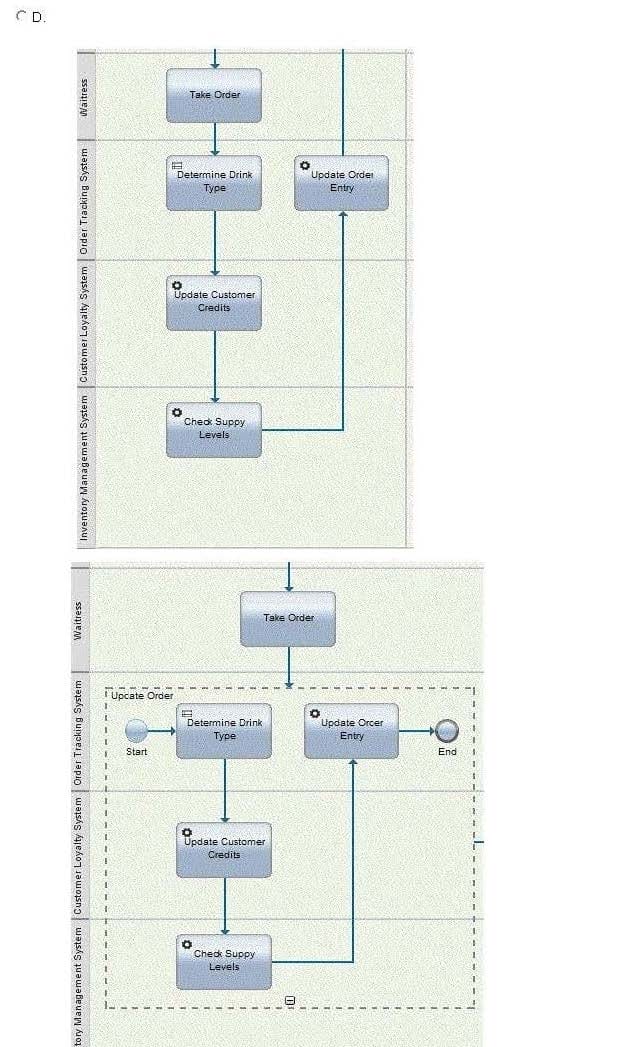
A. Exhibit A
B. Exhibit B
C. Exhibit C
D. Exhibit D
How does implementing the playback methodology in a BPM project reduce the risk of building unwanted products?
A. Business users are minimally involved in the BPM project.
B. All requirements of the project are completed in one release.
C. Solution administrators give estimates of system performance.
D. Immediate feedback during development provides ability to change direction.
During the discovery phase of a BPM project, the BPM analyst is supposed to define the goal for the process. Which goal of a car company follows the guidelines of the Specific Measurable Achievable Relevant Time-bound (SMART) acronym?
A. Increase production of car parts by July 31, 2014.
B. Increase the quality of North American cars by 5% in 2 weeks.
C. Reduce coal emissions in European car factories by 10%.
D. Reduce fuel economy for newly released cars from 30 km/hr to 45 km/hr by August 31, 2016.
During the Process Discovery phase, the BPM analyst needs to schedule and plan for the Process Improvement and Discovery Workshop (PIDW). In planning the PIDW, what activities should the BPM analyst include on the agenda in addition to the following? 1. Prepare workshop participants.
2. Introduce BPM. 3. Identify business case overview. 4. Determine business impact.
A. 5. Implement the business process.
6.
Develop the use cases.
7.
Discuss findings and proposed solution.
B. 5. Document the business process inventory and roadmap.
6.
Develop the solution approach.
7.
Discuss detailed estimates.
C. 5. Document the business process.
6.
Develop the solution approach.
7.
Discuss findings and proposed solution.
D. 5. Demonstrate the business process playback.
6.
Develop the use cases.
7.
Discuss findings and proposed solution.
A BPM analyst is modeling the process for acquiring an account. During an interview with the customer service supervisor, the BPM analyst was provided with a Responsible, Accountable, Consulted, Informed (RACI) chart that had been created with the key roles and activities in the process.

The BPM analyst used the contents of the RACI chart to fill in the Details fields in Blueworks Live for the activity "Enter Application". According to the RACI chart for the activity "Enter Application", who is the Participant?
A. Customer Service Agent
B. Customer Service Supervisor
C. Customer Relations Advisor
D. Customer Account Manager
During process discovery, the business subject matter experts (SMEs) make the following statement about how the process starts: "Today, our users access the database that stores new orders and copy that information manually onto a request form. This form is passed from one participant to another during the process. In our future state, we would like IBM Business Process Manager V8.0 to connect to the database directly, so that we don't have to manually create our request forms." The IT representatives from the client indicate that this should be possible. How should the BPM analyst respond to this?
A. Defer this discussion for the BPM developers.
B. Gather all the technical details for this integration.
C. Capture that the process should start systematically and identify high level inputs to the process.
D. Inform the business SMEs that this is not possible as the process must start with a Human Task.
During a process discovery session, the business subject matter experts (SMEs) and the BPM analyst have created the following process for a "3rd Party Grant Writing Process":
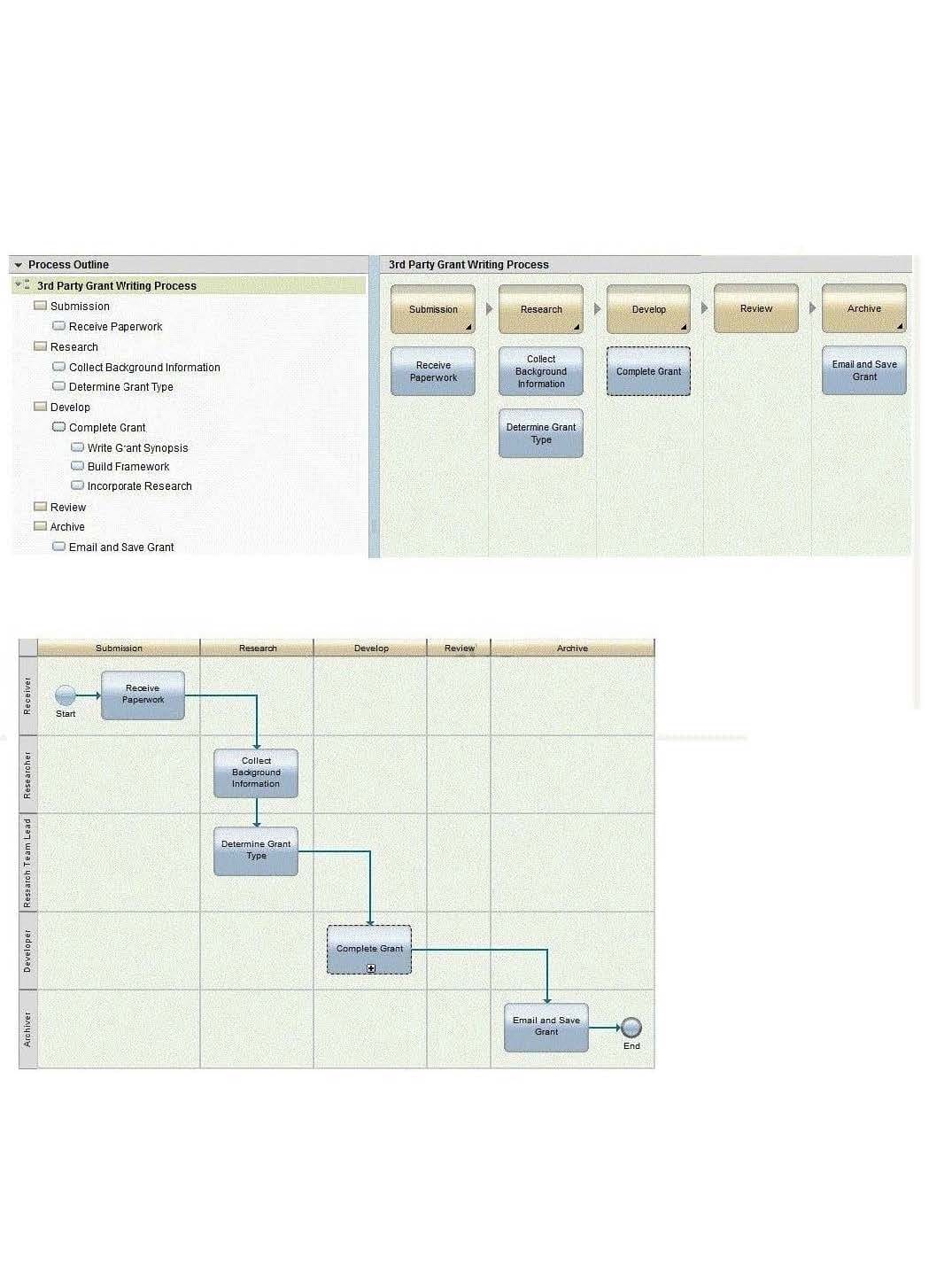
The business subject matter experts (SMEs) insist that the review after the "Develop" activities will be completed outside of the process platform. The process platform will be alerted that the reviews are complete and the process should proceed to the "Archive" activities".
How should the BPM analyst adjust the process so that the business requirements can be captured and a BPM Developer can have enough information to build an executable process?
A. Combine the "Review" milestone and the "Archive" milestone into "Review and Archive"
B. Insert an Exception event on the process flow between "Complete Grant" and 'Email and Save Grant'
C. Add a system swimlane and a message event to receive the review message (placed in new swimlane and the "Review" milestone)
D. Add a swimlane to the process diagram for a "Reviewer" role and an activity to accept the reviews (placed in new swimlane and the 'Review'milestone)
A cable company is improving a process in their call center for requesting cable service. The new process will run in IBM Business Process Manager V8.0. The call center supervisor would like to know how long it takes the customer service representatives to answer the customer requests before passing the request to the engineering department to provide the service. What should the BPM analyst recommend to address the measurement reporting requirement?
A. Use the My Performance scoreboard with Provide Cable Service filter.
B. Use the My Team Performance scoreboard with the Answer Customer Request activity.
C. Use IBM Business Monitor to create a custom report with events from the engineering department database.
D. Create a custom report with tracking points in the process with cable service customer names.
A security company provides background checks on individuals as a service. Based on various criteria, a customer's request can have a different priority to receive a better level of service response time. Whether the background check passes or fails should not impact the service level. Requests with a high priority need to be addressed within the same business day, those with a medium priority can take up to 3 days to process, and those with a low priority must be responded to within 5 business days. The security company is currently updating the background check process and wants to define some performance measurements to ensure customers are receiving the service level they are paying for. How should the BPM analyst define the measurements to meet these requirements?
A. Calculate the rate of background check passes per day per priority to determine the service level agreement.
B. Count the number of background check failures for each priority and calculate the difference from the service level agreement.
C. Capture the times to start and complete the background check, calculate the duration and compare it to the service level agreement by priority.
D. Capture the times to start and complete the background check, calculate the service level agreement for each priority and compare it to thetimes.
A company needs to improve their hiring process using a Business Process Management System (BPMS). Currently, their hiring manager writes a free form email regarding a new open position and sends it to the HR manager for approval. The hiring manager wants to standardize this activity using a BPMS. How should the BPM analyst define this user story?
A. As a BPMS, I want to provide an electronic form to the Hiring Manager, so that the Hiring Manager can complete the request.
B. As a BPMS, I want to provide an electronic form instead of a document so that the data can be saved and retrieved for reporting purposes.
C. As a Hiring Manager, I want to have a user interface with all the fields necessary to complete the hiring request form, so that I can avoid using aword document.
D. As a Hiring Manager, I want to complete the hiring request form and submit the form to the HR Manager, so that the HR Manager can review myrequest and make a decision on filling this position.
A BPM analyst has completed the definition of user stories and is ready to prioritize them so that the development team starts building the stories that have high business value. What BPM project roles must attend the user story prioritization session?
A. BPM Developers and Project Managers
B. BPM Administrators and Project Managers
C. Process Owners and Subject Matter Experts
D. Integration Developers and Subject Matter Experts
